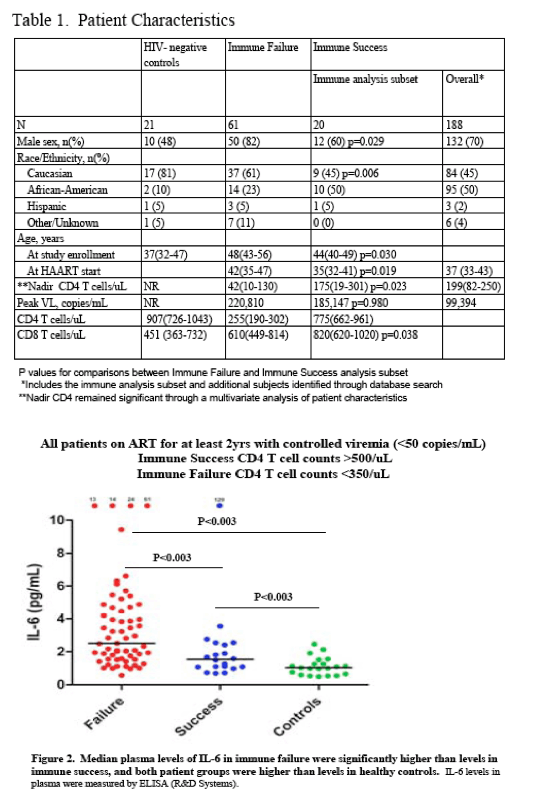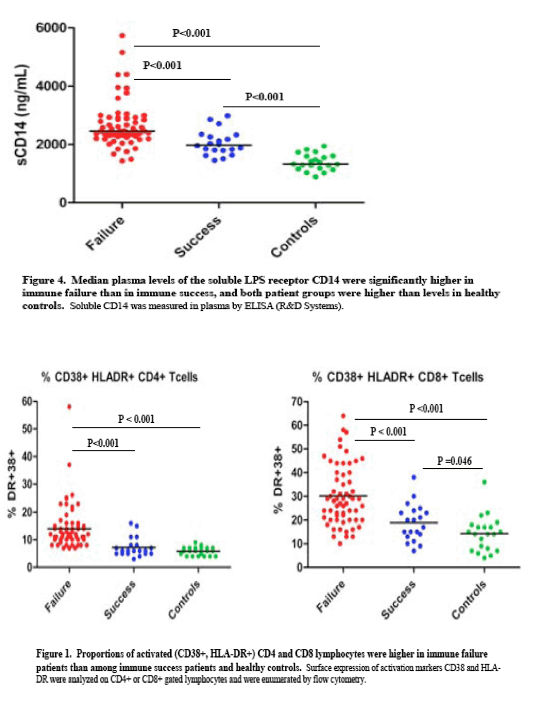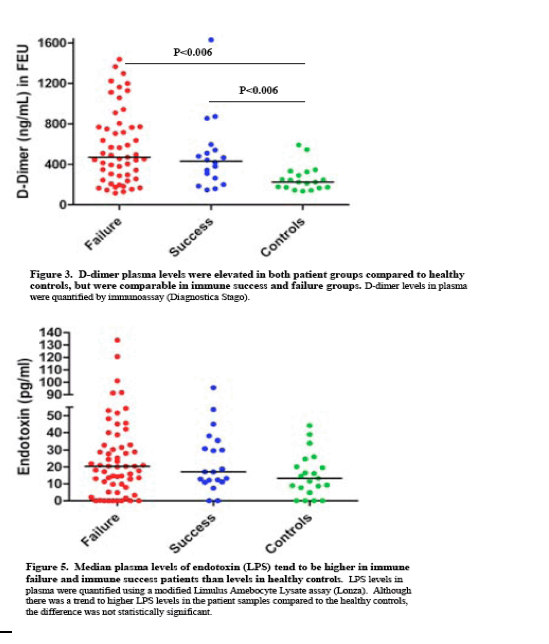 |
 |
 |
| |
Immunologic Failure Despite Suppressive ART Is Related to Increased Inflammation and Evidence of Microbial Translocation and Inflammation & Activation Persist Even Despite Immune Success
|
| |
| |
Reported by Jules Levin
CROI 2011 arch 2 Boston
"Immune failure despite ART-induced control of HIV replication is associated with increased lymphocyte activation (CD38+ HLA-DR+) and increased plasma levels of IL-6 and sCD14 that are likely related to persistent microbial translocation. D- dimer levels were significantly greater in both immune failure and immune success patients than in healthy controls, suggesting persistent prothrombotic tendency in treated HIV infection irrespective of immunologic restoration.".....from Jules: this study finds inflammation and immune activation persists and is greater in HIV+ with >500 cd4 & undetectable viral load compared to HIV-negs. nadir CD4 was lower in immune failures saying low nadir cd4, delaying start of HAART, is associated with persistent inflammation despite success of HAART with >500 CD4 and undetectable viral load and a 2nd study on treatment with HAART by Deeks et al at CROI suggests the same as they found treating within 6 months of infection significantly reduced immune activation compared to starting HAART 2 years later, and if waited 2 yrs to begin HAART immune activation likely persists forever.
Carey Shive1, M Lederman1, L Calabrese2, N Funderburg1, H Bonilla3, B Gripshover1, R Salata1, G McComsey1, S Sieg1, and B Rodriguez1
1Case Western Reserve Univ Sch of Med and Univ Hosps Case Med Ctr, Cleveland, OH, US; 2Cleveland Clin Fndn, OH, US; and 3Summa Hlth System, Akron, OH, US
Background: Despite control of HIV replication with ART, many patients fail to restore circulating CD4 T cells to normal levels. Patients with low circulating CD4 T cells are at increased risk for morbidity. This study examined soluble indices of inflammation and microbial translocation. Methods: We examined immune activation (surface expression of CD38 and HLA-DR) and soluble markers of inflammation (IL-6), coagulation (D-dimers) and microbial translocation (sCD14 and lipopolysacharride (LPS)) by flow cytometry (surface markers) or ELISA and Limulus Amebocyte Lysate assay (soluble markers) in plasmas of 61 patients with immune failure despite effective control of HIV replication, in 21 healthy controls and in 20 immune success patients. Immune failure was defined as CD4 <350/uL after at least 2 yrs of virologic control (plasma HIV RNA below the limit of detection). Patients with "immune success" had CD4 >500/uL after at least two years of virologic control on ART. Differences between groups were assessed using two-sided Mann-Whitney's U tests with a significance cutoff of 0.05, without formal correction for multiple comparisons.
Results: The proportion of activated CD4 T cells in immune failure (12%) was significantly greater (p < 0.001) than in immune success and in healthy controls (6% for each); as were proportions of activated CD8 T cells (28%) compared to immune success patients (19%) and healthy controls (14%). Median plasma levels of IL-6 in immune failure (2.5 pg/mL) were higher than levels in immune success (1.53 pg/mL, p =0.003) and both were higher than levels in controls (1.01 pg/mL, p =0.003, p =0.02). In contrast, D-dimer levels were similar in immune failure and immune success (442 and 401 ng/mL) and both were higher than levels in healthy controls (224 ng/mL, p = 0.006, p = 0.022). Levels of soluble CD14, the LPS coreceptor, were higher in immune failure (2674 ng/mL) than in immune success (2056 ng/mL, p < 0.001) and both were higher than levels in healthy controls (1390 ng/mL, p < 0.001 for both comparisons). Median levels of LPS tended to be higher in immune failure (20.4 pg/mL) and immune success (17.1 pg/mL) than in controls (13.3 pg/mL), but these differences were not significant (p = 0.09 and 0.16). In immune failures and in all patients sCD14 and IL- 6 levels were correlated (r=.275, p =0.032, r= .322 p=0.003 respectively) and in immune failures, known duration of untreated HIV infection was related to IL-6 (r=.454, p=.001) and to D-dimer levels (r=.406, p =.004).
Conclusions: Immune failure despite ART-induced control of HIV replication is associated with increased lymphocyte activation (CD38+ HLA-DR+) and increased plasma levels of IL-6 and sCD14 that are likely related to persistent microbial translocation. D- dimer levels were significantly greater in both immune failure and immune success patients than in healthy controls, suggesting persistent prothrombotic tendency in treated HIV infection irrespective of immunologic restoration.



|
| |
|
 |
 |
|
|